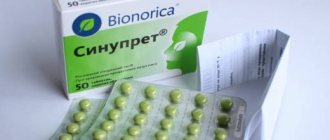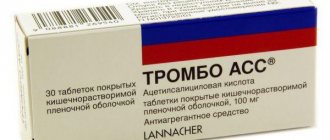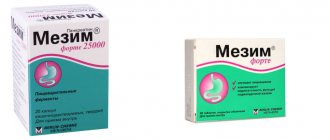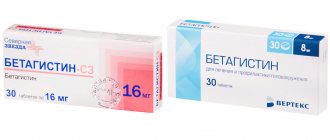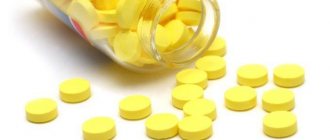| Pantoprazole | |
| Pantoprazole | |
| Chemical compound | |
| IUPAC | ( RS )-5-(difluoromethoxy)-2-[(3,4-dimethoxypyridin-2-yl)methylsulfinyl]-3H - benzoimidazole |
| Gross formula | C₁₆H₁₅F₂N₃O₄S |
| Molar mass | 383.371 g/mol |
| CAS | 102625-70-7 |
| PubChem | 4679 |
| DrugBank | APRD00073 |
| Classification | |
| ATX | A02BC02 |
| Pharmacokinetics | |
| Bioavailable | 77% |
| Metabolism | hepatic (CYP2C19 and CYP3A4) |
| Half-life | 1 hour |
| Excretion | with urine |
| Method of administration | |
| internal, intravenous | |
| Other names | |
| “Controlok”, “Pantap”, “Ulsepan”. | |
Pantoprazole
is an inhibitor of H+/K+ATPase (proton pump), a blocker of hydrochloric acid secretion.
Antiulcer drug. The original molecule, under the trade name Controloc, was developed by Takeda (formerly Nycomed). It is also sold under the trademarks PanGastro
,
Sanpraz
,
Pantap, Ulsepan.
pharmachologic effect
H+/K+ATPase inhibitor. Blocks the final stage of hydrochloric (hydrochloric) acid secretion, reduces the level of basal and stimulated (regardless of the type of stimulus) secretion of hydrochloric (hydrochloric) acid in the stomach. In case of duodenal ulcer associated with Helicobacter pylori, a decrease in gastric secretion increases the sensitivity of the microorganism to antibiotics.
Does not affect gastrointestinal motility. Secretory activity normalizes 3-4 days after stopping the drug.
Indications
- peptic ulcer of the stomach or duodenum in the acute phase;
- erosive gastritis (including those associated with Helicobacter pylori);
- erosive and ulcerative lesions of the stomach and duodenum associated with taking NSAIDs;
- reflux esophagitis;
— eradication of Helicobacter pylori in combination with two antibiotics;
- Zollinger-Ellison syndrome and other pathological conditions associated with increased gastric secretion.
Pantoprazole
Presented in pharmacies under the names:
- Nolpaza
; - Control
.
Depending on the dosage and packaging, the price of a package starts from 200 rubles.
It is also a proton pump inhibitor. Available in tablets.
The mechanism of action is similar to Omeprazole. Protects the mucous membranes of the stomach from an aggressive acidic environment. Prevents the development of complications, including ulcer perforation. Increases the effectiveness of anti-Helicobacter therapy.
The speed of onset of the effect depends on the diagnosis and dosage regimen. A persistent improvement in condition is observed 7 days after the start of treatment.
Symptoms of dyspepsia, such as stomach pain and heartburn, disappear from the first days of taking the pills.
The drug differs from other inhibitors in its chemical resistance to the effects of other medications.
Clinical trials have confirmed the effectiveness of the drug in:
- Zollinger-Ellison syndrome;
- treatment of exacerbations and prevention of peptic ulcer;
- erosive gastritis caused by taking gastrotoxic drugs, for example, analgesics and hormones;
- gastroesophageal reflux disease.
Note! For dyspepsia of a neurotic nature, the medicine should not be taken.
Other restrictions on use are:
The drug is taken once a day, in long courses (1-2 months).
For pathologies caused by the activity of bacteria Helicobacter pylori, it is used in combination with antimicrobial agents according to special regimens.
Dosage regimen
For gastric and duodenal ulcers and erosive gastritis, the drug is prescribed at a dose of 40-80 mg/day. The course of treatment for exacerbation of duodenal ulcer is 2 weeks, and for gastric ulcer - 4-8 weeks.
To prevent exacerbations of gastric and duodenal ulcers, 20 mg/day is prescribed.
To eradicate Helicobacter pylori, take 40 mg 2 times a day in combination with antimicrobial agents. The course of therapy is 7-14 days.
For erosive and ulcerative lesions of the stomach and duodenum associated with taking NSAIDs, 40-80 mg/day is prescribed. The course of treatment is 4-8 weeks. For the prevention of erosive lesions during long-term use of NSAIDs - 20 mg/day.
For reflux esophagitis, 20-40 mg/day is prescribed. The course of therapy is 4-8 weeks. To prevent exacerbations, take 20 mg/day.
In patients with severe liver dysfunction, the dose should be reduced to 40 mg 1 time every 2 days, while biochemical blood parameters must be monitored. If the activity of liver enzymes increases, the drug should be discontinued.
The tablets are taken orally whole (without crushing or dissolving), with a sufficient amount of liquid. It is recommended to take the drug 1 hour before breakfast; if taken twice a day, the second dose is 1 hour before dinner.
Pantoprazole 40 mg tablets, instructions for use
Name: Pantoprazole.INN: Pantoprazole.
ATX code: A02BC02.
Analogues: Pantap, Nolpaza, Pantasan.
Description: biconvex oval tablets, grayish-pink in color, with the inscription “P40” in black on one side.
Compound:
Each enteric-coated tablet contains:
Active substance:
pantoprazole (in the form of pantoprazole sodium sesquihydrate) – 40.0 mg;
Excipients: sodium carbonate anhydrous; mannitol; sucrose; talc; titanium dioxide; calcium stearate; silicon dioxide; hypromellose; macrogol; copolymer of methacrylic acid and ethyl acrylate (1:1) 30% dispersion; triethyl citrate; iron oxide red; iron oxide black; opacode black (S-1-17823): shellac [glaze-45% (20% esterified) in ethanol], isopropyl alcohol, black iron oxide colorant, n-butyl alcohol, propylene glycol, ammonium hydroxide (28%).
Dosage form: enteric-coated tablets.
Pharmacotherapeutic group: Proton pump inhibitors.
pharmachologic effect
Pharmacodynamics
Pantoprazole is a substituted benzimidazole that inhibits gastric acid secretion by specifically blocking parietal cell proton pumps. Pantoprazole is converted to its active form, cyclic sulfenamide, in an acidic environment in the parietal cells, where it inhibits the enzymes H+, K+-ATPase, i.e. the final stage of the formation of hydrochloric acid in the stomach.
Inhibition is dose dependent and affects both basal and stimulated acid secretion. For most patients, resolution of heartburn and acid reflux symptoms is achieved within the first week. Pantoprazole reduces acidity in the stomach and thereby increases gastrin levels in proportion to the decrease in acidity. The increase in gastrin content is reversible. Because the drug binds to an enzyme distal to the receptor, it can inhibit the secretion of hydrochloric acid regardless of stimulation by other substances (acetylcholine, histamine, gastrin). The effect is the same whether the active substance is taken orally or intravenously.
The use of drugs that suppress the secretion of hydrochloric acid is associated with a response increase in the level of serum gastrin.
With short-term use, most often this level does not exceed the upper limit of normal. During long-term treatment, gastrin levels double in most cases. Excessive enlargement is rare. As a result, in a small number of cases, a slight or moderate increase in the number of specific endocrine cells (from simple cases to adenomatoid hyperplasia) is observed during long-term treatment. However, according to studies to date, the formation of carcinoid precursors (atypical hyperplasia) or gastric carcinoids, as found in animal experiments, has not been observed in humans.
When the acidity of gastric juice decreases, the level of chromogranin A increases, which can distort the results of studies during a diagnostic examination to identify neuroendocrine tumors. Available published data suggest that proton pump inhibitors should be discontinued 5 to 14 days before planned CgA measurements. This allows chromogranin A levels to be normalized to normal values, which may be false positive after taking proton pump inhibitors.
Clinical effectiveness
In a retrospective analysis of 17 studies of 5960 patients with gastroesophageal reflux who were treated with pantoprazole 20 mg, symptoms associated with acid reflux (heartburn, acid regurgitation) were assessed according to standardized methodology. Cases selected for the study were required to have at least one record of an acid reflux symptom in a two-week period. The diagnosis of gastroesophageal reflux in these studies was based on endoscopic evaluation, with the exception of one study in which patient selection was based solely on symptomatology. In these studies, the percentage of patients who were completely free of heartburn after 7 days was 54.0-80.6% in the pantoprazole group. After 14 and 28 days, complete relief from heartburn was found in 62.9-88.6% and 68.1-92.3% of patients, respectively.
For complete relief of acid regurgitation, similar results were obtained as in the case of heartburn. After 7 days, the percentage of patients completely relieved of acid regurgitation was 61.5-84.4%, after 14 days - 67.7-90.4% and after 28 days - 75.2-94.5%.
Pantoprazole consistently showed better efficacy than H2 receptor antagonists and no worse than other proton pump inhibitors. Relief of acid reflux symptoms was significantly dependent on the initial stage of gastroesophageal reflux.
Pharmacokinetics
Pharmacokinetics after single or repeated administration do not differ. Over the dose range of 10 to 80 mg, the plasma kinetics of pantoprazole are linear after both oral and intravenous administration.
Suction
Pantoprazole is completely and rapidly absorbed after oral administration. Absolute bioavailability was found to be approximately 77%. On average, approximately 2.0-2.5 hours after oral administration of a single 20 mg dose (tmax), a maximum serum concentration (Cmax) of approximately 1-1.5 mg/ml is reached and these values remain constant. after repeated injections. Concomitant food intake had no effect on bioavailability (AUC or Cmax), but increased latency variability (tlag).
Spreading
The volume of distribution is approximately 0.15 l/kg and serum protein binding is approximately 98%.
Metabolism and excretion
The elimination rate is approximately 0.1 l/h/kg, and the terminal half-life (t1/2) is approximately 1 hour. There are data on several cases of increased period
half-life. Due to the specific binding of pantoprazole to proton pumps within the parietal cell, the half-life does not correspond to a longer period of action (inhibition of acid secretion).
Pantoprazole is metabolized in the liver. Renal excretion represents the main route of elimination (approximately 80%) of pantoprazole metabolites. A small amount is excreted in the feces.
The main metabolite in serum and urine is desmethylpantoprazole, which combines with sulfate. The half-life of the main metabolite (approximately 1.5 hours) is no longer than for pantoprazole.
Special Populations:
Impaired renal function:
No dose reduction is required in patients with impaired renal function (including patients on hemodialysis). As with healthy volunteers, the half-life of pantoprazole is short. Although the main metabolite has a longer half-life, elimination is rapid and does not accumulate.
Liver dysfunction:
After taking pantoprazole in patients with liver cirrhosis (Child-Pugh classes A and B), the half-life increases to 3-7 hours and the AUC value increases 3-6 times, while Cmax increases only 1.3 times. compared to healthy volunteers.
Elderly patients:
A small increase in AUC and Cmax in elderly patients compared to younger patients has not been clinically proven.
Indications for use
- Gastroesophageal reflux disease, reflux esophagitis;
- Eradication of Helicobacter pylori (as part of complex therapy);
- Duodenal ulcer;
- Stomach ulcer;
- Zollinger-Ellison syndrome and other pathological hypersecretory diseases.
Directions for use and doses
Inside, before meals (usually before breakfast), with the required amount of water. The tablets should be swallowed whole without chewing.
Adults and teenagers aged 12 years and older:
Treatment of gastroesophageal reflux disease, reflux esophagitis.
1 tablet of Pantoprazole per day. In some cases, the dose can be increased to 2 Pantoprazole tablets per day. It usually takes 4 weeks to treat esophageal reflux. If necessary, the duration of treatment is increased to 8 weeks.
Adults:
Eradication of Helicobacter pylori (in complex therapy).
In Helicobacter pylori-positive patients, eradication of microorganisms is achieved using combination therapy.
In combination therapy for the eradication of Helicobacter pylori infection, the second tablet of Pantoprazole must be taken before dinner. Combination therapy is usually carried out for 7-10 days and can be extended to a maximum of two weeks. If further treatment with Pantoprazole is required to cure the ulcer, dosage recommendations for the treatment of duodenal and gastric ulcers should be considered.
Treatment of stomach ulcers:
1 tablet of Pantoprazole per day. In some cases, the dose can be increased to 2 Pantoprazole tablets per day. It usually takes 4 weeks to heal a stomach ulcer. If necessary, the duration of treatment is increased to 8 weeks.
Treatment of duodenal ulcer:
1 tablet of Pantoprazole per day. In some cases, the dose can be increased to 2 Pantoprazole tablets per day. It usually takes 2 weeks to heal a duodenal ulcer. If necessary, the duration of treatment is increased to 4 weeks.
Zollinger-Ellison syndrome and other pathological hypersecretory diseases:
For long-term treatment of Zollinger-Ellison syndrome and other pathological hypersecretory diseases, treatment begins with a daily dose of 80 mg (2 tablets of Pantoprazole 40 mg each). After which the dose can be increased or decreased as necessary, guided by indicators of gastric acid secretion. For daily dosages greater than 80 mg, the dose should be divided and administered twice daily. It is possible to temporarily increase the dosage to more than 160 mg, but only for the time necessary to adequately suppress the secretion of hydrochloric acid. The duration of treatment for Zollinger-Ellison syndrome and other pathological hypersecretory diseases is not limited and can be carried out in accordance with clinical need.
Children under 12 years of age:
Pantoprazole is not recommended for use in children under 12 years of age due to the lack of data available for this age group.
Special Populations:
For patients with severe liver dysfunction, the dose should be reduced to 1 tablet (40 mg Pantoprazole) every day. Moreover, it is necessary to monitor liver enzyme levels in such patients during treatment with Pantoprazole. If liver enzyme levels increase, you should stop taking Pantoprazole.
The daily dose of Pantoprazole 40 mg should not be exceeded when treating elderly patients or patients with impaired renal function. An exception is combination therapy for Helicobacter pylori eradication, when elderly patients should take the usual dose of Pantoprazole (2x40 mg/day) during treatment.
Side effects
Approximately 5% of patients may experience side effects from the drug. The most common side effects: diarrhea and headache - occur in approximately 1% of patients.
The following unwanted side effects of Pantoprazole have been recorded:
From the hematopoietic organs: very rarely – thrombocytopenia, leukopenia.
From the nervous system and sensory organs: infrequently – headache, dizziness, sleep disturbance. Rarely - impaired visual acuity, depression (and aggravation). Very rarely - disorientation. Frequency unknown - hallucinations, confusion (especially in patients previously predisposed to this, as well as exacerbation of these symptoms if they were previously present).
From the digestive system: infrequently – diarrhea, nausea, vomiting, bloating and flatulence, constipation, dry mouth, pain and discomfort in the abdomen, often – stomach polyps (benign).
From the urinary system: frequency unknown – interstitial nephritis.
From the skin: uncommon – rash, exanthema, itching. Rarely - urticaria, Quincke's edema. Frequency unknown - Stevens-Johnson syndrome, toxic epidermal necrolysis, erythema multiforme, photosensitivity.
From the musculoskeletal system: rarely – arthralgia, myalgia.
From the side of metabolism and water-electrolyte metabolism: rarely – hyperlipemia and increased levels of fats (triglycerides, cholesterol), changes in body weight. Frequency unknown - hyponatremia.
From the immune system: rarely – hypersensitivity (including anaphylactic reactions and anaphylactic shock).
From the liver and biliary tract: infrequently - increased levels of liver enzymes (transaminases, g-GT). Rarely - increased bilirubin levels. Frequency unknown - hepatocellular liver damage.
Other: infrequently - asthenia, dysphoria, fatigue. Rarely – increased body temperature, peripheral edema.
Contraindications
Hypersensitivity to Pantoprazole, soy or other components of the drug. Concomitant use of atazanavir. Due to insufficient data, the use of Pantoprazole for the treatment of children under 12 years of age is not recommended.
With caution: pregnancy, lactation, liver failure.
Overdose
There is no information on overdose. Doses up to 240 mg administered intravenously over 2 minutes were well tolerated. Since Pantoprazole is highly bound to plasma proteins, it is poorly susceptible to hemodialysis. In case of overdose with clinical signs of intoxication, in addition to symptomatic and supportive treatment, there are no specific therapeutic recommendations.
Use during pregnancy and lactation.
Experience with the use of Pantoprazole in pregnant women is very limited. Evidence of mild fetotoxicity has been observed in animal reproduction studies. Preclinical studies have shown no evidence of decreased fertility or any teratogenic effects. The potential risk of using the drug in humans remains unknown. This medicine is not recommended for use during pregnancy.
There are no data on the excretion of Pantoprazole into breast milk in humans. Since the possibility of a risk to the child cannot be completely excluded, it is necessary to interrupt breastfeeding during treatment with Pantoprazole.
Precautionary measures
Patients with prolonged, recurring symptoms of indigestion or heartburn should see their doctor regularly. It is especially important for patients over 55 years of age to tell their doctor if they are taking any over-the-counter medication daily for dyspepsia or heartburn.
Patients should not take any other proton pump inhibitor or H2 receptor antagonist concomitantly.
If patients require endoscopy or a urease breath test, you should consult your doctor before taking this medicine.
Patients should be advised that taking pills does not provide immediate relief. Relief of symptoms may begin within about a day of starting treatment with Pantoprazole, but it may be necessary to take the drug for 7 days or more to completely eliminate heartburn. Patients should not take the drug as a prophylactic agent.
Reduced gastric acidity, due to any reason, including the use of proton pump inhibitors, increases the number of bacteria that are normally present in the gastrointestinal tract. Treatment with acid-reducing drugs leads to a small increase in the risk of developing gastrointestinal infections caused by Salmonella, Campylobacter, or C. difficile.
Elevated levels of chromogranin A (CgA) may interfere with diagnostic testing for neuroendocrine tumors. To avoid this, use of proton pump inhibitors should be discontinued at least five days before measuring serum chromogranin levels. If CgA and gastrin levels have not returned to normal after the initial measurement, chromogranin levels should be repeated 14 days after stopping proton pump inhibitors.
Impact on the ability to drive vehicles and other potentially dangerous mechanisms. Due to the risk of developing adverse reactions during treatment with the drug, it is necessary to refrain from driving vehicles and engaging in activities that require increased concentration.
Interaction with other drugs
Pantoprazole may reduce the absorption of active substances whose bioavailability depends on the pH level in the stomach (for example, iron salts, ketoconazole).
It has been demonstrated that co-administration of atazanavir 300 mg or ritonavir 100 mg with omeprazole (40 mg once daily) or atazanavir 400 mg with lansoprazole (60 mg single dose) in healthy volunteers resulted in a significant decrease in the bioavailability of atazanavir. The absorption of atazanavir is pH dependent. Therefore, Pantoprazole should not be used concomitantly with atazanavir.
Pantoprazole is metabolized in the liver using the cytochrome P450 enzyme system. The interaction of Pantoprazole with other substances that are metabolized by the same enzyme system cannot be excluded. However, no clinically significant interactions were observed in individual studies with carbamazepine, caffeine, diazepam, diclofenac, digoxin, ethanol, glibenclamide, metoprolol, naproxen, nifedipine, phenytoin, piroxicam, theophylline and oral contraceptives containing levonorgestrel and ethinyl estradiol.
No interaction was observed during concomitant use with warfarin in clinical pharmacokinetic studies. Several isolated cases of changes in the International Normalized Ratio (INR) have been reported during concomitant treatment in the post-marketing period. Therefore, patients taking indirect anticoagulants (eg, phenprocoumon or warfarin) are advised to monitor prothrombin time/INR after starting and stopping Pantoprazole or during intermittent use.
No interaction with concomitantly taken antacids was observed.
Storage conditions
Store in a place protected from moisture and light at a temperature not exceeding 25 °C.
Keep out of the reach of children.
Shelf life : 2 years.
Package
14 or 28 tablets in polymer jars with a tension lid with first opening control. One jar along with instructions for use is placed in a cardboard pack.
Vacation conditions
By doctor's prescription.
Manufacturer's name and address
Manufactured by: Jubilant Generics Limited, India
Packaged: RUE "Belmedpreparaty"
Side effect
From the central nervous system: headache; very rarely - depression, weakness, dizziness, blurred vision.
From the digestive system: diarrhea, nausea, pain in the upper abdomen, constipation, flatulence; in isolated cases - severe hepatocellular liver damage with jaundice, liver dysfunction.
Allergic reactions: skin rash, itching, skin hyperemia, anaphylactic reactions (up to shock).
Other: painful tension of the mammary glands, hyperthermia.






